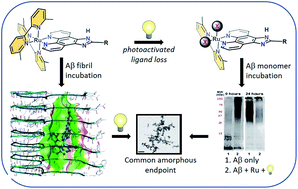Modification of amyloid-beta peptide aggregation via photoactivation of strained Ru(ii) polypyridyl complexes†
Abstract
Alzheimer's disease (AD) is a chronic neurodegenerative disorder characterized by progressive and irreversible damage to the brain. One of the hallmarks of the disease is the presence of both soluble and insoluble aggregates of the amyloid beta (Aβ) peptide in the brain, and these aggregates are considered central to disease progression. Thus, the development of small molecules capable of modulating Aβ peptide aggregation may provide critical insight into the pathophysiology of AD. In this work we investigate how photoactivation of three distorted Ru(II) polypyridyl complexes (Ru1–3) alters the aggregation profile of the Aβ peptide. Photoactivation of Ru1–3 results in the loss of a 6,6′-dimethyl-2,2′-bipyridyl (6,6′-dmb) ligand, affording cis-exchangeable coordination sites for binding to the Aβ peptide. Both Ru1 and Ru2 contain an extended planar imidazo[4,5-f][1,10]phenanthroline ligand, as compared to a 2,2′-bipyridine ligand for Ru3, and we show that the presence of the phenanthroline ligand promotes covalent binding to Aβ peptide His residues, and in addition, leads to a pronounced effect on peptide aggregation immediately after photoactivation. Interestingly, all three complexes resulted in a similar aggregate size distribution at 24 h, forming insoluble amorphous aggregates as compared to significant fibril formation for peptide alone. Photoactivation of Ru1–3 in the presence of pre-formed Aβ1–42 fibrils results in a change to amorphous aggregate morphology, with Ru1 and Ru2 forming large amorphous aggregates immediately after activation. Our results show that photoactivation of Ru1–3 in the presence of either monomeric or fibrillar Aβ1–42 results in the formation of large amorphous aggregates as a common endpoint, with Ru complexes incorporating the extended phenanthroline ligand accelerating this process and thereby limiting the formation of oligomeric species in the initial stages of the aggregation process that are reported to show considerable toxicity.



 Please wait while we load your content...
Please wait while we load your content...